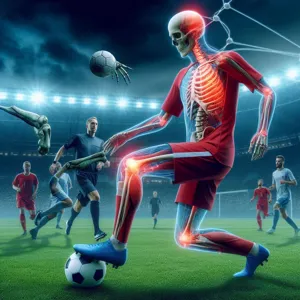Soccer, known as the beautiful game, captivates millions around the globe with its blend of skill, speed, and strategy.
However, the excitement of playing can quickly be overshadowed by the risk of injuries, which are all too common on the field. From sprained ankles to pulled muscles, such injuries can sideline athletes and disrupt their enjoyment of the sport. But fear not—there are effective strategies that can help players of all ages and skill levels stay safe while enjoying the game they love. In this comprehensive guide, we’ll explore essential techniques for injury prevention, covering everything from proper warm-up routines and effective conditioning programs to the importance of wearing the right gear. Whether you’re a seasoned pro or just kicking off your soccer journey, our tips will equip you with the knowledge you need to keep the game going strong and ensure that your time on the pitch is both safe and enjoyable. So lace up your cleats and get ready to dive into the world of injury prevention in soccer—because it’s game on!
1. Understanding Common Soccer Injuries

Understanding common soccer injuries is a crucial first step in preventing them on the field. Soccer, while exhilarating and dynamic, can also be tough on the body, leading to a variety of injuries that affect players of all ages and skill levels. The most frequent injuries include sprains, strains, contusions, and fractures, each of which can sideline players and disrupt their game.
Sprains, particularly of the ankle and knee ligaments, often occur during sudden changes in direction or when a player collides with another. These injuries can vary in severity, ranging from mild to severe, and may require everything from rest and ice to surgical intervention. Strains, which involve the muscles or tendons, frequently affect the hamstrings and quadriceps, especially during sprinting or kicking.
Contusions, or bruises, can result from direct contact with another player or the ball, and while they may seem minor, they can still cause significant pain and mobility issues. Fractures, though less common, can occur from falls or harsh tackles and typically require a longer recovery time.
In addition to these physical injuries, players may also face overuse injuries, such as tendinitis or stress fractures, stemming from repetitive motions over time. Understanding the mechanics behind these injuries is essential for players, coaches, and trainers alike. By recognizing the signs and symptoms associated with these common injuries, individuals can take proactive measures to minimize risk, making informed decisions about training, conditioning, and recovery strategies. Ultimately, knowledge is power, and being aware of the potential injuries that lurk on the field is the first line of defense against the unpredictable nature of soccer.
2. Importance of Proper Warm-Up Techniques
Warming up before a soccer game or training session is not just a ritual; it’s a crucial component of injury prevention that sets the tone for performance on the field. Proper warm-up techniques enhance blood flow to the muscles, increase body temperature, and prepare the joints for the dynamic movements that soccer demands. When players engage in focused warm-up routines, they are not merely going through the motions—they are actively reducing their risk of injuries such as strains, sprains, and tears.
A well-structured warm-up should include a mix of aerobic exercises, dynamic stretches, and sport-specific drills. Begin with light jogging or skipping to elevate the heart rate, gradually transitioning into dynamic movements like high knees, butt kicks, and leg swings that mimic the actions of the game. This not only helps to loosen muscles but also improves coordination and flexibility. Incorporating soccer drills, such as passing and dribbling exercises, can further engage the body and mind, preparing players for the tactical demands of the match.
Moreover, the psychological benefits of a proper warm-up should not be overlooked. Engaging in these techniques helps players mentally transition from their daily lives into the competitive mindset required for soccer. It fosters camaraderie among teammates, as they share these moments together, building team spirit before stepping onto the pitch.
In essence, investing time in proper warm-up techniques is a small but significant step that can lead to major improvements in performance and injury prevention. By prioritizing this crucial aspect of training, players set themselves up for success and longevity in the sport, ensuring they can give their best every time they lace up their cleats.
3. The Role of Stretching in Injury Prevention

Stretching plays a pivotal role in injury prevention for soccer players, serving as a cornerstone of any comprehensive warm-up and training routine. When players engage in stretching exercises, they not only enhance flexibility but also promote blood flow to the muscles, ensuring that they are adequately prepared for the vigorous demands of the game. This is particularly crucial in a sport like soccer, where quick directional changes, explosive sprints, and dynamic movements are the norm.
Incorporating both static and dynamic stretching into pre-game and training sessions can significantly reduce the risk of muscle strains and ligament injuries. Dynamic stretching, which involves moving parts of your body through a full range of motion, helps activate the muscles and improves overall coordination. Examples include leg swings, walking lunges, and high-knees, all of which mimic the movements players will perform on the field. On the other hand, static stretching, where muscles are stretched to their limit and held for a period, can be beneficial post-game to aid recovery and increase flexibility over time.
Additionally, players should pay close attention to their major muscle groups, such as the hamstrings, quadriceps, hip flexors, and calves. A well-rounded stretching routine that targets these areas can help alleviate muscle tightness, improve balance, and enhance overall performance.
Moreover, it’s essential for coaches and athletes alike to recognize the importance of making stretching a consistent part of their regimen. This commitment to flexibility not only enhances physical readiness but also fosters a culture of injury prevention within the team. By prioritizing stretching, players can enjoy the beautiful game with greater confidence, knowing they are taking proactive steps to safeguard their health and longevity in the sport.
4. Choosing the Right Footwear
Choosing the right footwear is a cornerstone of injury prevention in soccer, and it’s a decision that can significantly impact a player’s performance and safety on the field. Soccer cleats are designed with specific features that cater to the demands of the game, providing traction, stability, and protection. When selecting soccer shoes, players need to consider several key factors to ensure they make the best choice for their individual needs and the playing conditions.
First and foremost, it’s essential to choose cleats that are appropriate for the type of surface you’ll be playing on. Firm ground (FG) cleats are ideal for natural grass pitches, featuring conical or bladed studs that provide optimal grip without digging too deep into the ground. In contrast, soft ground (SG) cleats, with longer and fewer studs, are designed for wet or muddy fields, allowing for better traction and maneuverability. Turf shoes, characterized by a flat sole with small rubber studs, are perfect for artificial turf surfaces, offering stability and comfort.
Fit is another critical aspect of selecting the right footwear. Soccer cleats should snugly wrap around the foot without being overly tight, allowing for proper blood circulation while minimizing the risk of blisters and discomfort. It’s advisable to try on cleats with the same type of socks you’ll wear during games to gauge the fit accurately. Additionally, consider the width of the shoe; players with wider feet may benefit from brands that offer options in various widths.
Lastly, investing in quality footwear can’t be overstated. While it may be tempting to opt for the cheaper option, high-quality cleats are often constructed with better materials, providing enhanced durability and support. Look for features such as reinforced toe caps, cushioned insoles, and lightweight materials that can help reduce fatigue during play. By taking the time to choose the right footwear, players can enjoy a more comfortable and safer experience on the pitch, significantly reducing their risk of injuries and enhancing their overall game performance.
5. Importance of Hydration and Nutrition

In the fast-paced world of soccer, where every sprint, tackle, and skill move counts, the role of hydration and nutrition cannot be overstated. Proper hydration is essential for maintaining peak physical performance and preventing injuries. Water is the body’s lifeblood, and even mild dehydration can lead to fatigue, decreased coordination, and increased susceptibility to cramps and strains. Players should aim to drink water consistently throughout the day, not just during practice or matches. A good rule of thumb is to hydrate well before stepping onto the field—ideally, drink water or electrolyte-rich fluids in the hours leading up to play.
But hydration alone isn’t enough; nutrition plays a pivotal role in preparing athletes for the rigors of the game. A balanced diet rich in carbohydrates, proteins, and healthy fats fuels the body, providing the necessary energy for those high-intensity moments on the pitch. Carbohydrates are especially crucial, as they are the primary source of energy during prolonged physical activity. Opt for whole grains, fruits, and vegetables to maximize nutrient intake while ensuring sustained energy levels.
Protein, on the other hand, is vital for muscle recovery and repair. Incorporating lean meats, fish, legumes, and dairy into meals helps build and maintain muscle strength, which is essential for injury prevention. Additionally, healthy fats from sources like avocados, nuts, and olive oil support overall health and provide energy for longer matches.
Timing is also key. Consuming a balanced meal about two to three hours before a match can optimize performance, while a snack rich in carbohydrates can provide a quick energy boost right before play. Post-game nutrition is equally important. Refueling with a blend of protein and carbohydrates within 30 minutes of the final whistle aids recovery, replenishing glycogen stores and repairing muscle tissue.
Ultimately, understanding the importance of hydration and nutrition is a game-changer for soccer players. By prioritizing these aspects, athletes not only enhance their performance but also significantly reduce their risk of injuries, ensuring they can stay on the field where they belong. So, the next time you lace up your cleats, remember: hydrate, fuel, and play smart!
6. Techniques for Safe Tackling and Falling
When it comes to playing soccer, the thrill of the game often leads to aggressive maneuvers on the field, including tackling and defensive plays. However, these actions can also result in injuries if not executed correctly. Understanding and mastering safe tackling techniques is crucial not only for your safety but for the safety of your teammates and opponents as well.
To execute a safe tackle, always approach your opponent with control. Rather than lunging in recklessly, maintain a low center of gravity by bending your knees and keeping your body balanced. This position allows you to use your body weight effectively while reducing the risk of falling and injuring yourself or your opponent. Aim to tackle the ball, not the player; focus on making contact with the ball first and ensure you’re using the inside of your foot for better control.
Should you find yourself in a situation where falling is inevitable, knowing how to fall safely can make all the difference. When you’re about to hit the ground, try to relax your body and roll as you fall. This technique disperses the force of the impact across a larger area, minimizing the risk of injury. Tuck your chin to your chest to protect your head and keep your arms close to your body to avoid any hyperextension.
Additionally, practicing these techniques during training sessions can help players become more confident and skilled in their tackling and falling methods. Incorporate drills that simulate game scenarios, allowing players to practice safe tackling in a controlled environment. By prioritizing safe tackling and falling techniques, you’ll not only enhance your own game but contribute to a safer playing environment for everyone on the field. Remember, playing smart is just as important as playing hard!
7. Strengthening Exercises for Soccer Players

Strengthening exercises are a cornerstone of any soccer training program, crucial for enhancing performance and, most importantly, preventing injuries on the field. Soccer is a physically demanding sport that requires a combination of speed, agility, and endurance, all while navigating the unpredictable dynamics of gameplay. By integrating a well-rounded regimen of strengthening exercises, players can bolster their muscle resilience, improve stability, and support their joints, ultimately leading to a more robust athletic performance.
One effective approach is to focus on the major muscle groups utilized in soccer, particularly the legs, core, and upper body. For instance, exercises like squats and lunges target the quadriceps, hamstrings, and glutes, building the strength needed for powerful sprints and effective tackling. Plyometric exercises, such as box jumps or lateral hops, enhance explosive power and agility, allowing players to change direction quickly without sacrificing balance.
Core exercises, such as planks and Russian twists, are equally vital. A strong core stabilizes the body, enabling players to maintain proper posture while running, jumping, and kicking. This stability not only enhances performance but also protects against strains and injuries, particularly in the lower back and hips.
Don’t overlook the importance of upper body strength either. Exercises like push-ups and bent-over rows help build arm and shoulder strength, which is essential for shielding the ball and maintaining balance during physical confrontations with opponents.
Incorporating these strengthening exercises into a regular training routine, ideally two to three times a week, can have a significant impact on a player’s overall fitness. Not only will it elevate their game, but it will also foster a greater sense of body awareness, allowing players to recognize their limits and adjust their movements accordingly, further minimizing the risk of injury. Remember, a strong player is a safe player, and investing time in strengthening exercises is one of the best strategies to keep yourself on the pitch, game after game.
8. Incorporating Rest and Recovery into Training
In the fast-paced world of soccer, where every sprint, tackle, and dribble can take a toll on the body, the importance of incorporating rest and recovery into training cannot be overstated. While it may be tempting to push players to their limits in pursuit of peak performance, understanding the value of recovery is essential for preventing injuries and ensuring longevity in the sport.
Rest and recovery strategies should be woven seamlessly into a player’s training regimen. This means recognizing that a well-rounded training schedule includes not only intense practice sessions but also dedicated downtime. Implementing a structured recovery program can help alleviate muscle fatigue, reduce the risk of overuse injuries, and enhance overall athletic performance.
Active recovery, such as light jogging, yoga, or swimming, can be incredibly beneficial. These low-impact activities promote blood circulation and help muscles recover without putting additional strain on the body. Additionally, incorporating regular stretching and flexibility exercises can enhance range of motion, making players less susceptible to injuries.
Moreover, sleep is a critical component of recovery that is often overlooked. Quality sleep allows the body to repair itself and helps regulate hormones that affect performance and recovery. Encouraging players to prioritize sleep hygiene—such as maintaining a consistent sleep schedule, creating a comfortable sleep environment, and limiting screen time before bed—can significantly impact their overall well-being and ability to perform on the field.
Nutrition also plays a fundamental role in recovery. Providing players with guidance on proper hydration and balanced meals, rich in nutrients and antioxidants, can help reduce inflammation and support muscle recovery. A focus on post-training nutrition, including protein-rich snacks and carbohydrate replenishment, will ensure that players are fueling their bodies effectively.
By fostering a culture that values rest and recovery, coaches and players alike can mitigate the risk of injuries and enhance performance. Remember, in soccer, as in life, sometimes less truly is more. Prioritizing recovery not only keeps players on the field but also empowers them to play at their best, game after game.
9. The Role of Coaching in Injury Prevention
Coaching plays a pivotal role in injury prevention, serving not only as a guide for skill development but also as a crucial factor in maintaining the overall health and well-being of players. A knowledgeable coach understands that a well-structured training program is essential in minimizing the risk of injuries. This involves not just focusing on technical skills but also integrating physical conditioning, flexibility training, and recovery protocols into the practice regimen.
One of the key responsibilities of a coach is to educate players on the importance of proper warm-up routines. A thorough warm-up increases blood flow to the muscles, enhancing their elasticity and readiness for physical exertion. Coaches should emphasize dynamic stretching and sport-specific drills that prepare the body for the demands of a soccer match.
Additionally, coaches must prioritize player fitness levels, tailoring training sessions to accommodate the varying abilities within the team. This individual approach helps to avoid overexertion and fatigue, which are common precursors to injuries. Regularly assessing players’ physical conditions and adjusting training loads accordingly can make a significant difference in injury rates.
Communication is another vital aspect of effective coaching in injury prevention. Coaches should foster an environment where players feel comfortable expressing any discomfort or concerns about their physical condition. This open dialogue allows for early intervention and appropriate modifications to training or gameplay, reducing the likelihood of injuries escalating into more serious issues.
Lastly, coaches should stay informed about the latest injury prevention techniques and research within the sport. By attending workshops and collaborating with sports medicine professionals, they can implement evidence-based strategies that keep players safe while enhancing performance. By taking a proactive approach to injury prevention, coaches not only protect their players but also contribute to a positive team culture that values health, wellness, and longevity in the game.
10. Monitoring Player Fatigue and Load Management
Monitoring player fatigue and load management is a crucial aspect of injury prevention in soccer that often goes overlooked. As the pace of the game accelerates and the demands on athletes increase, it becomes essential for coaches and trainers to keep a close eye on the physical and mental well-being of their players. Fatigue can significantly impair performance and increase the risk of injuries, making it imperative to implement systematic monitoring techniques.
One effective method is to utilize technology such as GPS trackers and heart rate monitors during training sessions and matches. These tools provide valuable data on player load, including distance covered, sprinting frequency, and even recovery times. By analyzing this information, coaches can gauge whether players are reaching their physical limits, allowing for timely adjustments to training intensity or game participation.
Moreover, incorporating regular wellness checks can help assess players’ overall fatigue levels. Simple surveys or verbal check-ins can reveal how players are feeling both physically and mentally, enabling coaches to identify those who may need additional rest or modified training routines. Beyond the numbers, fostering open communication creates an environment where athletes feel comfortable expressing their concerns, ultimately promoting a culture of health and safety.
Load management also extends to understanding the importance of recovery. Adequate rest days, proper nutrition, hydration, and sleep are vital components that should not be neglected. Implementing recovery protocols, such as ice baths, physiotherapy, and active recovery sessions, can enhance players’ resilience and preparedness for upcoming matches.
By prioritizing monitoring player fatigue and load management, teams can significantly reduce the risk of injuries while optimizing performance. A proactive approach in this area not only keeps players on the field but also contributes to their long-term development and success in the sport. Ultimately, making fatigue management a central pillar of training regimens ensures that athletes are not just playing the game, but playing it at their best.
11. Recognizing Signs of Overtraining
Recognizing signs of overtraining is crucial for maintaining peak performance and preventing injuries in soccer. As athletes push their limits in pursuit of excellence, they may inadvertently cross the fine line between rigorous training and excessive strain on their bodies. Overtraining can manifest in various physical and mental symptoms, often insidiously creeping in before the athlete even realizes it.
Physically, players might experience persistent fatigue that lingers even after adequate rest. This exhaustion can lead to decreased performance, as sprints feel heavier and coordination becomes erratic. Muscle soreness that doesn’t subside after a few days, joint pain, or frequent injuries can also signal that the body is struggling to recover from the demands placed upon it. Additionally, a decline in overall performance, such as slower sprint times or missed passes that were once routine, can be an early indicator of overtraining.
Mentally, the signs are just as telling. Athletes may notice increased irritability, anxiety, or a loss of motivation. The joy of playing might diminish, replaced by feelings of dread about training sessions or matches. Sleep disturbances, whether it’s difficulty falling asleep or restless nights, can also be a subtle hint that recovery is being compromised.
To combat overtraining, it’s essential for players, coaches, and parents to cultivate awareness of these signs. Keeping a training log can help track performance and mood changes, allowing for timely adjustments to training regimens. Regular check-ins with coaches or sports psychologists can facilitate open discussions about mental well-being, ensuring athletes feel supported. Importantly, incorporating rest days and active recovery sessions into training schedules can help mitigate the risk of overtraining, allowing players to recharge both physically and mentally. By recognizing and addressing the signs of overtraining, athletes can preserve their health, sustain their passion for the game, and ultimately enhance their long-term performance on the field.
12. The Importance of Cross-Training
Cross-training is a crucial yet often overlooked component of a well-rounded soccer training regimen. While dedicating time to practice dribbling, shooting, and tactical formations is essential, incorporating various forms of exercise can significantly enhance a player’s overall performance and reduce the risk of injuries.
Engaging in different types of physical activity, such as swimming, cycling, or strength training, allows players to develop complementary muscle groups and improve their cardiovascular endurance without overloading the specific muscles used in soccer. For instance, swimming provides a low-impact workout that helps build lung capacity and overall fitness while allowing for recovery from the repetitive strain that soccer can place on the joints.
Moreover, cross-training helps prevent imbalances that can lead to injuries. Soccer players often rely heavily on certain muscles, which can cause weaknesses in others. By integrating exercises that focus on flexibility, balance, and coordination—such as yoga or pilates—athletes can enhance their core strength and stability, which are vital for maintaining proper form during gameplay.
Additionally, cross-training can keep the training regimen fresh and mentally stimulating. By varying workouts, players can stave off boredom and maintain motivation, which is essential for consistent performance. This holistic approach not only prepares athletes for the physical demands of the sport but also fosters a greater understanding of their own bodies, helping them to recognize the signs of fatigue and avoid overexertion.
Incorporating cross-training into a soccer player’s routine is not just about preventing injuries; it’s about building a more resilient, agile, and adaptable athlete. By diversifying their training, players can enhance their skills on the field, ensuring they remain at the top of their game season after season.
13. Tips for Young Players and Parents
As the world of soccer continues to grow in popularity, more young players are eager to lace up their cleats and hit the pitch. For parents, ensuring that their aspiring athletes remain safe and healthy while enjoying the sport is paramount. Here are some essential tips for young players and their parents to help prevent injuries and create a positive soccer experience.
First and foremost, proper warm-up and cool-down routines cannot be overstated. Encourage young players to dedicate at least 10-15 minutes before and after practice or games to stretching and light exercises. This helps to increase blood flow to the muscles, improve flexibility, and reduce the risk of strains and sprains. Incorporate dynamic stretches—like leg swings and arm circles—during warm-ups and static stretches—like hamstring and quadriceps stretches—during cool-downs.
Another critical aspect is the importance of using the right gear. Ensure that young players wear well-fitting cleats designed for soccer, as this significantly enhances grip and minimizes the risk of ankle injuries. Additionally, shin guards are essential for protecting against kicks and impacts. Parents should invest in quality gear and regularly check for proper fit, as children grow quickly and may need new equipment throughout the season.
Hydration plays a vital role in injury prevention as well. Encourage players to drink water before, during, and after games and practices, especially on hot days. Dehydration can lead to muscle cramps and fatigue, increasing the likelihood of injuries. Parents should remind their children to stay hydrated, and they can even pack water bottles for practices and games to make it easier.
Moreover, teaching young players about the importance of listening to their bodies is crucial. Encourage them to speak up if they feel pain or discomfort, rather than pushing through it. Instilling this awareness can help prevent minor issues from escalating into more serious injuries. Parents should foster an open and supportive environment where young athletes feel comfortable sharing their concerns.
Lastly, remind young players to focus on skill development rather than just winning. Prioritizing proper techniques and sportsmanship can lead to a more enjoyable experience and reduce the risk of injuries that often arise from aggressive play. Encourage them to practice skills like passing, dribbling, and shooting in a controlled manner, emphasizing the value of teamwork and respect on the field.
By following these essential tips, young players and their parents can create a safer and more enjoyable soccer experience, allowing athletes to thrive while minimizing the risk of injury. With a focus on preparation, safety, and skill development, the beautiful game can be enjoyed year after year.
14. Case Studies: Successful Injury Prevention Programs
In the realm of soccer, where the thrill of the game often collides with the harsh reality of injuries, innovative injury prevention programs have emerged as vital tools for safeguarding players. By examining successful case studies from various clubs and organizations, we can glean valuable insights into effective strategies that not only reduce injury rates but also enhance overall player performance.
One standout example is the renowned Ajax Youth Academy in the Netherlands, which has long been a trailblazer in youth development and injury prevention. By integrating a comprehensive approach that combines strength training, flexibility exercises, and injury risk assessment, Ajax has significantly reduced the incidence of injuries among its young athletes. Their program emphasizes the importance of monitoring players’ physical loads, ensuring that training intensity is both challenging and safe. This meticulous attention to detail has not only kept players on the field but has also fostered a culture of awareness around injury prevention.
Across the Atlantic, Major League Soccer’s (MLS) Health and Performance department has implemented a groundbreaking injury prevention initiative known as the “Injury Prevention and Performance Program” (IPPP). This program utilizes data analytics to assess individual player biomechanics and tailor training regimens accordingly. By identifying potential risk factors specific to each athlete, teams can implement targeted interventions, such as personalized warm-up routines and recovery protocols. The results have been impressive, with participating teams reporting a marked decrease in soft tissue injuries and an increase in player availability throughout the season.
Another noteworthy case is the Football Association (FA) in England, which launched the “Football Medicine and Performance Association” (FMPA). This collaborative effort brings together sports scientists, physiotherapists, and coaches to develop evidence-based injury prevention practices. Through workshops, research, and the dissemination of best practices, the FMPA has empowered clubs at all levels to adopt a proactive stance against injuries. Their commitment to education ensures that everyone involved in the sport, from grassroots to elite levels, is equipped with the knowledge to prevent injuries effectively.
These case studies illustrate that successful injury prevention programs are not one-size-fits-all solutions. Instead, they require a tailored approach that considers the unique needs and dynamics of each team and its players. By investing in comprehensive training, utilizing data-driven insights, and fostering a culture of collaboration, soccer organizations can create environments where players can thrive, free from the threat of injury. As we strive to keep the beautiful game safe and enjoyable, learning from these successful initiatives is a crucial step toward achieving that goal.
15. Conclusion: Building a Culture of Safety in Soccer
In conclusion, building a culture of safety in soccer is not just an afterthought; it is a fundamental pillar that supports the integrity and longevity of the sport. When coaches, players, and officials prioritize safety, they set the tone for an environment where athletes can thrive without the constant worry of injury. This culture begins with education—ensuring that everyone involved understands the risks associated with the game and the best practices to mitigate them. Regular training sessions focused on injury prevention techniques, like proper warm-ups, stretching, and conditioning, should be integrated into the routine of every team.
Moreover, open communication plays a crucial role in fostering a safe environment. Athletes should feel empowered to speak up about their physical condition, report injuries, and voice concerns without fear of judgment or repercussion. Coaches must model this behavior by being vigilant and responsive to the needs of their players, emphasizing the importance of listening to one’s body and taking necessary precautions.
Additionally, clubs and organizations should invest in proper equipment, medical resources, and training for coaching staff to ensure that they are well-equipped to handle injuries should they arise. This investment not only protects players but also reinforces the commitment to their well-being.
Ultimately, creating a culture of safety is about more than just preventing injuries—it’s about nurturing a love for the game. When players feel safe and supported, they are more likely to enjoy their experience, develop their skills, and return to the field time and time again. By prioritizing safety, we can ensure that soccer remains a beloved sport for generations to come. Game on!
As we wrap up our exploration of essential strategies to prevent injuries in soccer, we hope you feel empowered to take proactive steps both on and off the field. By prioritizing proper warm-ups, investing in the right gear, and fostering a culture of communication and awareness within your team, you can significantly reduce the risk of injuries and enhance overall performance. Remember, a healthy player is a happy player, and safeguarding against injuries not only contributes to individual well-being but also ensures that your team can consistently compete at its best. So, lace up your cleats, put these strategies into practice, and take the field with confidence—because with the right preparation, it’s game on!






